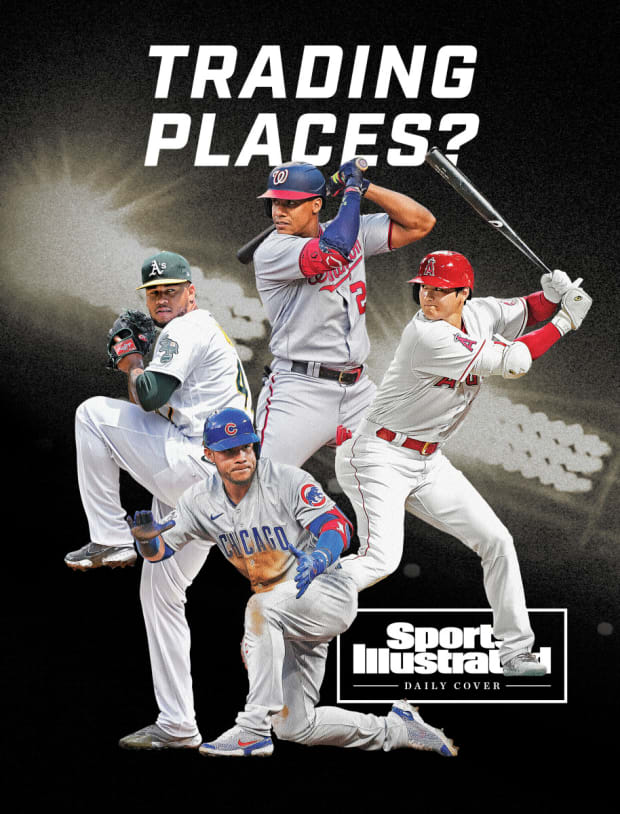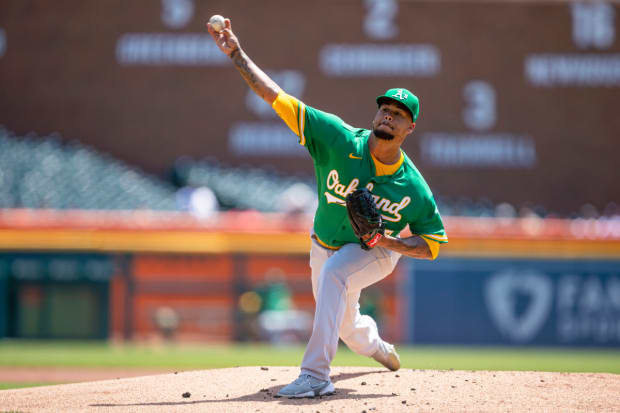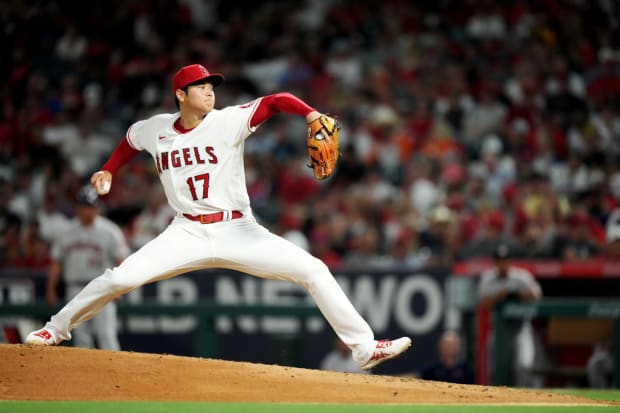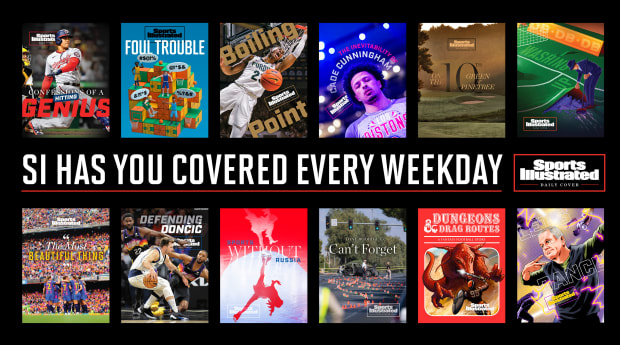If there is a lesson to be learned from recent trade deadlines, it is this: If you’re not making a move, you’re falling behind. Even the good teams cannot pass on the opportunity of the last acquisition window. Over the past four full seasons, no team has reached the World Series without making a key midseason deal, including trades that brought in four postseason series MVPs (Eddie Rosario, Jorge Soler, Steve Pearce and Justin Verlander), two World Series Game 7 starters (Zack Greinke and Yu Darvish) and a World Series Game 7 closer (Daniel Hudson).
The market this year is energized by two unprecedented factors: six playoff spots in each league and the best player ever available at the trade deadline, Juan Soto. Never has a player been on the market who is this young (23), this good (one of only six players, and the first since 1955, to hit 100 homers at 23 with more walks than strikeouts) and this controllable (two more seasons after this one).
The pressure for teams to act at the deadline is intense. The general manager who lets the deadline pass without a deal faces more scrutiny than the one who takes a chance. Expectations rise because of the success of recent deadline trades. As the clock ticks toward the 6 p.m. ET deadline Tuesday, here are the decision-makers under the most pressure:

1. Mike Rizzo, Nationals
The time is now. Soto can affect three pennant races today. If he is still a National after 6 p.m. Tuesday, he can affect only two. His value immediately is diminished. Rizzo can never “win” a trade, because Soto simply has too much value as this unprecedented trade chip. The closest comp is Miguel Cabrera, who was 24 with two years of control when the Marlins traded him to the Tigers. The Marlins turned down offers from the Angels involving Howie Kendrick and Ervin Santana to obtain Detroit’s two best prospects, Cameron Maybin and Andrew Miller. It’s a reminder to never get carried away with prospect “rankings.” The deal was a bust for the Marlins.
As Tigers manager Jim Leyland said at the time, “You can wait a lifetime to get a player like Cabrera.”
Rizzo must concentrate on getting the two best young players from another system and then adding two or three more to the package. I would start with C.J. Abrams and MacKenzie Gore of the Padres.
The most motivated suitors are three of the four teams that never have won a World Series: the Padres, Rangers and Mariners. As then Cubs president Theo Epstein said when he traded Gleyber Torres for Aroldis Chapman in 2016, “If not now, when?” We’re talking about a franchise-changing player in Soto for teams that need a franchise-changing championship. The fourth franchise without a title, the Brewers, should also be in the hunt for Soto, but Milwaukee appears content with an offense that ranks fifth in runs per game.
The Cardinals, Yankees and Dodgers are also in play because they can trade from a resource of young talent without diminishing their major league team or their window to win in these next three seasons. The Padres seem to line up best when you combine motivation with trade chips.
2. A.J. Preller, Padres
The pressure to get Soto is high. Since Peter Seidler assumed ownership control from Ron Fowler, the Padres have spent 120% to 147% above the MLB average payroll after a decade of spending about 20% under the average. They feverishly have tried to buy and trade their way into the World Series (Wil Myers, Eric Hosmer, Manny Machado, Yu Darvish, Fernando Tatis Jr., Joe Musgrove, etc.) with mixed results. Preller has traded more WAR (126.3) than he has acquired in deals (70.8).
The payroll model in their market might not be sustainable—think the Diamondbacks from 2000 to ’02—but for now they are all in, and Preller needs Soto to finish it off by covering a gigantic flaw. Despite a top-five payroll and the fourth-toughest pitching staff to hit (.229), the Padres have an outfield OPS that is not just the worst of any contender (.644), but also the worst in franchise history.
3. Derek Falvey, Twins
Minnesota has the worst rotation ERA (4.19) among the 15 teams in playoff position or within 2 ½ games of a spot. Its rotation ranks 27th in innings. The Twins have lost 18 straight playoff games while getting just three quality starts. The last and only starter in franchise history to strike out 10 batters in a postseason game is Walter Johnson, who did it twice while pitching for the Washington Senators (Game 1 of the 1924 and ’25 World Series).
The door is open for the Twins to win a weak AL Central, but to get there and to win a postseason series for the first time in two decades, Falvey needs to improve the rotation.
4. John Mozeliak, Cardinals
With the status of Jack Flaherty uncertain, St. Louis needs to acquire a starting pitcher. In the same bind at the deadline last year, Mozeliak turned up Jon Lester and J.A. Happ, who went 9–3 in 23 combined starts. The Cardinals do love their pitch-to-contact pitchers. The staff ranks 28th in strikeout rate, but their defense is one of the best in the majors. The options this year include Frankie Montas, Carlos Rodón, Jake Odorizzi, José Urquidy, Noah Syndergaard and Nathan Eovaldi.

Raj Mehta/USA TODAY Sports
5. David Forst, A’s
Before the season, Oakland cashed in all but one of its best trade chips: Montas. The A’s sweated through a stint on the IL for Montas because of shoulder trouble. But he has returned with two somewhat abbreviated starts (53 and 78 pitches), and his stuff looks fine. His average fastball velocity over those two starts was 95.9 mph, just a smidgen down from his 96.2 average before the injury. He also had a slightly higher percentage of splitters.
With the trade of Luis Castillo from Cincinnati to Seattle, Montas is the best starter pitcher on the market. Time for Forst’s patience to be rewarded. Also available from Oakland: catcher Sean Murphy and outfielder Ramón Laureano.
6. Jed Hoyer, Cubs
He has a premier piece in catcher Willson Contreras, with a need at the position among the Rays, Mets and Astros. Hoyer has shown he knows how to cut a deal, often receiving major-league-ready talent in deals over the past two Julys involving Andrew Chafin, Anthony Rizzo, Ryan Tepera, Javier Báez, Kris Bryant, Craig Kimbrel, Jake Marisnick and Chris Martin.
7. James Click, Astros
Houston is the rare team with a surplus of starting pitchers from which to deal, but it still has a few loose threads to address. The 7–9 spots in the batting order are hitting .208, it has no left-handed relief specialist, 38-year-old first baseman Yuli Gurriel is hitting .171 with runners in scoring position and .232 against righthanders, and it needs a veteran backup catcher. Houston catchers are hitting .164, the third-worst such mark ever by any team. If the Astros don’t add an experienced backstop, an injury to defensive stalwart Martín Maldonado would be even more alarming.
8. Brian Cashman, Yankees
Not much urgency here. New York could swing a deal for Montas if the price is right, but Luis Severino should be returning to pitch behind Gerrit Cole and Nestor Cortes Jr. in the playoff rotation. For all the rumblings about needing a pitcher, the Yankees have the best swing-and-miss staff in baseball (14% of pitches).
Following the trade for Andrew Benintendi, the Yankees will give away Joey Gallo, who has no place on their postseason roster and who will leave as the worst hitting nonpitcher to wear pinstripes over at least 500 plate appearances (.159), well below Stephen Drew (.187) and Kyle Higashioka (.185).
9. Al Avila, Tigers
The rebuild to the rebuild starts here. Detroit has learned some of its placeholders are not worth banking on and that some of its young pitching which looked so good on paper has health and mechanical issues holding them back. Almost everybody is available, especially in the bullpen, including Gregory Soto, Michael Fulmer, Andrew Chafin and Joe Jiménez.
10. Team trainers
Even more so than in recent years, the return of star players from the injured list will go a long way in determining the next World Series champion. Begin with Jacob deGrom, who will start for the Mets on Tuesday in Washington one hour after the trade deadline passes. (Will Soto be in the lineup for Washington?) Other stars with returns on the horizon: Tatis and Gore of the Padres; Bryce Harper of the Phillies; Wander Franco of the Rays; Walker Buehler, Dustin May and Blake Treinen of the Dodgers, Severino and Giancarlo Stanton of the Yankees; Flaherty and Yadier Molina of the Cardinals; Freddy Peralta of the Brewers; Mitch Haniger of the Mariners; and Lance McCullers Jr. of the Astros.

Erick W. Rasco /Sports Illustrated
In addition to these decision-makers and players, here are some of the other most intriguing names and teams at the deadline:
1. Shohei Ohtani. Need an ace and a premier slugger? Yes, teams are calling on the Angels’ two-way star, but he’s not going anywhere—not with another year of control and not without Los Angeles exploring extension talks this winter. Trade talks will pick up then.
2. Josh Bell, Joc Pederson, Brandon Drury, J.D. Martinez, Ian Happ, Tommy Pham, Trey Mancini. There was a run on rental hitters in the final two deadline days last year (Kyle Schwarber, Anthony Rizzo, Jorge Soler, Javier Báez, Eddie Rosario, et al.). Look for the same flurry of activity. Teams shopping for a bat include the Braves (who need to replace Adam Duvall), Dodgers, Guardians, Astros, Rays and Mariners.
3. The Red Sox and Giants. They reached August with losing records after playing ugly in July, which puts them in that awkward in-between place between buyers and sellers. Both teams may move a player headed for free agency but are unlikely to buy at the top of the market.

4. Tyler Mahle, Noah Syndergaard, José Quintana. Just about every team in the wild-card hunt could use another starting pitcher. The Phillies are among this group and may want Mahle, who has another year of control, just as they grabbed Kyle Gibson last year. The Blue Jays could bring back Syndergaard to his original team, but they prefer Frankie Montas and will shop the veteran relief market, including Steve Cishek and David Robertson. The Orioles will listen on Mancini but are more likely to add a midlevel pitcher.
5. Mets vs. Braves. The battle for the NL East also takes place on the trade market for hitters. The Mets are not done after getting left-handed hitters Tyler Naquin and Daniel Vogelbach. While Willson Contreras should be the priority, a right-handed DH such as Martinez or Mancini could be a fallback. Likewise, Atlanta’s plan to replace Duvall could lead it to explore hitters such as Drury and Michael A. Taylor.







